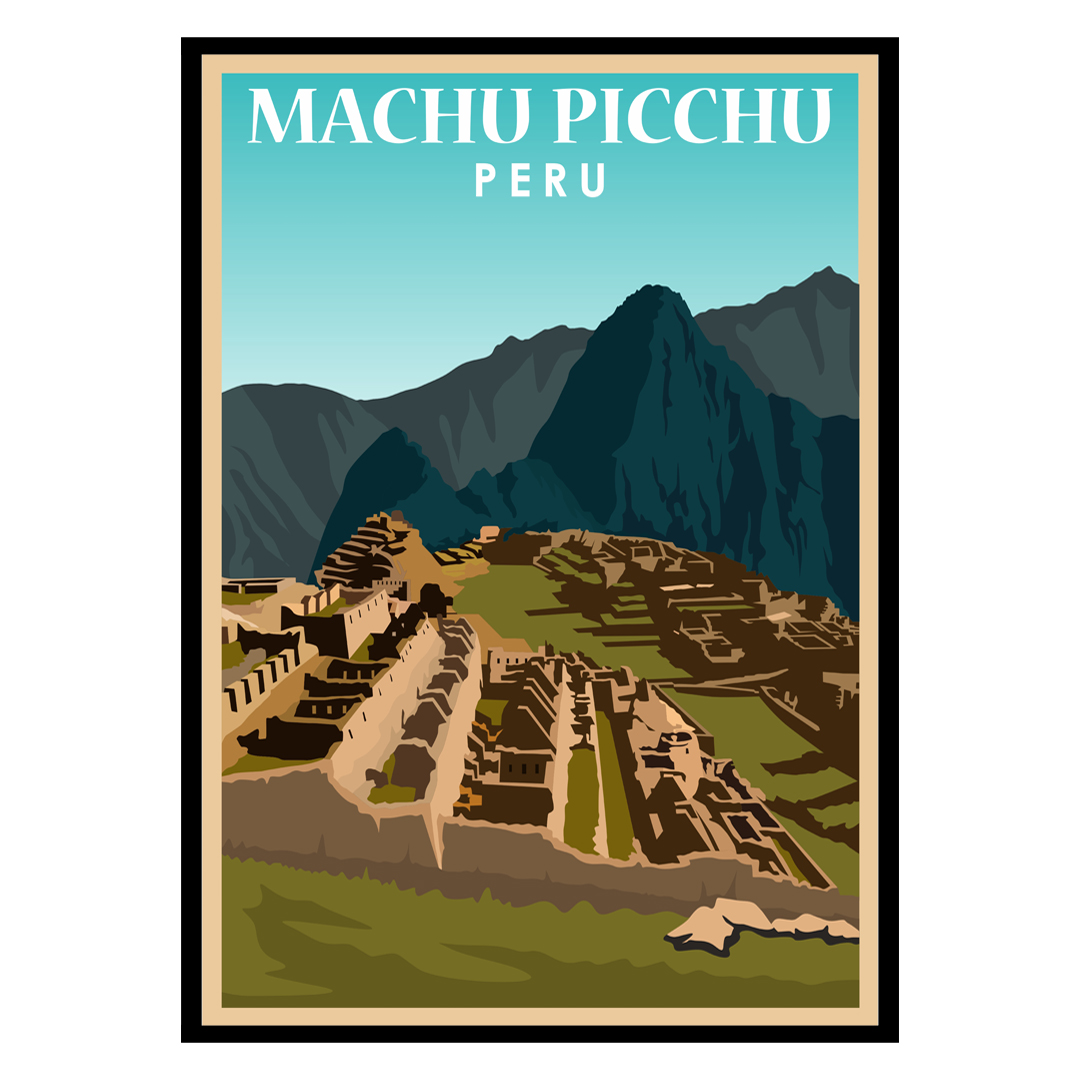Embark on a journey through time and marvel at the ancient wonders of Machu Picchu with our captivating poster.
Machu Picchu Poster
€15 – €49
Transport yourself to the mystical heights of the Andes Mountains and explore the enigmatic beauty of this UNESCO World Heritage Site. Let the majestic ruins and breathtaking vistas of Machu Picchu inspire your sense of wonder and adventure. Whether you’re an intrepid explorer or an armchair traveler, this stunning poster brings the spirit of this iconic Incan citadel into your home, inviting you to dream, discover, and wander through the mysteries of the past.
Machu Picchu is a 15th-century Inca citadel, located in the Eastern Cordillera of southern Peru, on a 2,430-metre (7,970 ft) mountain ridge. It is located in the Machupicchu District within Urubamba Province above the Sacred Valley, which is 80 kilometres (50 mi) northwest of Cuzco. The Urubamba River flows past it, cutting through the Cordillera and creating a canyon with a tropical mountain climate.
For most speakers of English or Spanish, the first ‘c’ in Picchu is silent. In English, the name is pronounced /ˌmɑːtʃuː piːtʃuː/ or /ˌmɑːtʃuː piːktʃuː/, in Spanish as [ˈmatʃu ˈpitʃu] or [ˈmatʃu ˈpiktʃu],[9] and in Quechua (Machu Pikchu)[ as [ˈmatʃʊ ˈpɪktʃʊ].
Most archaeologists believe that Machu Picchu was constructed as an estate for the Inca emperor Pachacuti (1438–1472). Often mistakenly referred to as the “Lost City of the Incas”, it is the most familiar icon of Inca civilization. The Incas built the estate around 1450 but abandoned it a century later at the time of the Spanish conquest. Although known locally, it was not known to the Spanish during the colonial period and remained unknown to the outside world until American historian Hiram Bingham brought it to international attention in 1911.
Machu Picchu was built in the classical Inca style, with polished dry-stone walls. Its three primary structures are the Intihuatana, the Temple of the Sun, and the Room of the Three Windows. Most of the outlying buildings have been reconstructed in order to give tourists a better idea of how they originally appeared. By 1976, 30% of Machu Picchu had been restored[11] and restoration continues.
Machu Picchu was declared a Peruvian Historic Sanctuary in 1981 and a UNESCO World Heritage Site in 1983. In 2007, Machu Picchu was voted one of the New Seven Wonders of the World in a worldwide internet poll.
According to an Machu Picchu article on CNN
For over 100 years, one of the most famous archaeological sites in the world, Machu Picchu, has been known by the wrong name, according to a report published in Ñawpa Pacha: Journal of the Institute of Andean Studies.The Incas who built the ancient city likely called it Huayna Picchu, the report said.
Huayna translates to “new or young,” while Picchu means “mountain peak” in the Indigenous Quechua language, said Emily Dean, professor of anthropology at Southern Utah University in Cedar City. She was not involved in the report. Machu means “old,” so we’ve been calling it old mountain peak, she added.The Incan settlement was believed to have been built around 1420 as an estate for royal Incas living in Cuzco, the capital of the Incan empire, according to report author Brian Bauer, professor of anthropology at the University of Illinois at Chicago.When the Spaniards later conquered the Incas, Huayna Picchu was abandoned, the report said. It was hidden for centuries deep in the Andes mountains until American explorer Hiram Bingham rediscovered it in 1911.
Museum-quality poster made on thick and durable matte paper. Add a wonderful accent to your room and office with these posters that are sure to brighten any environment.
• Paper thickness: 0.26 mm (10.3 mil)
• Paper weight: 189 g/m² (5.57 oz/y²)
• Opacity: 94%
• ISO brightness: 104%
• Giclée printing quality
• 21 × 30 cm posters are size A4
• Blank product sourced from Japan
| Weight | N/A |
|---|






There are no reviews yet.